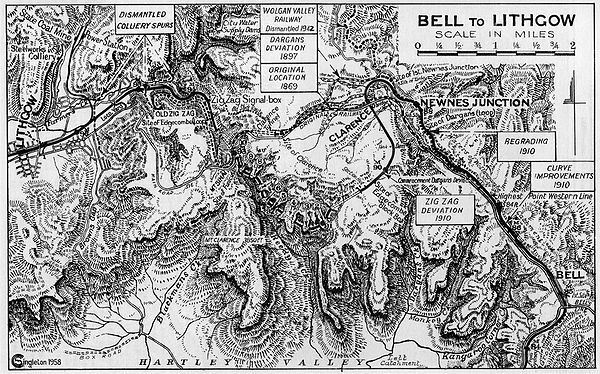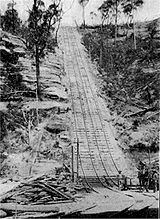
Ten Tunnels Deviation 1910, New South Wales
Encyclopedia
The Ten Tunnels Deviation is the section of track between Newnes Junction
and Zig Zag Box
in the Blue Mountains, New South Wales
. It was constructed between 1 June, 1908 and 16 October, 1910 to replace the Lithgow Zig Zag
, which limited the length of goods trains over the Mountains.

, where much of the navvies were temporarily housed. Here a temporary power station was established for rock drills, lighting, compressors, etc.
Access to the tunnel locations and the short open sections between the cliffs was extremely difficult. At one isolated point, horses and drays were placed on to the worksite by means of a crane and long jibs. There they remained until the tunnels were completed to provide them with a way out.
 The supply of materials for Nos. 8, 9 & 10 tunnels was expedited by the construction of a funicular of the 4-rail type from near Mount Sinai on the original line.
The supply of materials for Nos. 8, 9 & 10 tunnels was expedited by the construction of a funicular of the 4-rail type from near Mount Sinai on the original line.
Only experienced miners were employed on the more dangerous tunnelling activities, which were carried out by day and night.
The tunnels were situated on a maximum grade of 1 in 50. The line curves towards Newnes Junction after leaving the tunnels at the Sydney end.
Newnes Junction also had to be moved 660 metres to its current place, and two more tracks were also constructed for the Commonwealth Oil Refineries
Wolgan Valley Railway.
When the deviation was completed, much of the equipment was moved to the other deviation works at Glenbrook
, as well as the navvies
. As a result, the population of Clarence declined rapidly. The deviation was electrified along with the rest of the line in 1957.
In 1978, the roadbed of the Ten Tunnels was lowered to allow the new double deck interurbans to run on the line. The deviation today is still in use.
Newnes Junction railway station, New South Wales
Newnes Junction is a closed railway station on the Blue Mountains Line, New South Wales, Australia. It opened in 1910 and served the former private branch line to Newnes. The station closed to passenger services in 1975, although still physically exists and is occasionally used for coal trains...
and Zig Zag Box
Lithgow Zig Zag
The Lithgow Zig Zag was a zig zag railway built near Lithgow on the Great Western Railway of New South Wales in Australia which operated between 1870 and 1910, to overcome an otherwise insurmountable climb up the western side of the Blue Mountains...
in the Blue Mountains, New South Wales
New South Wales
New South Wales is a state of :Australia, located in the east of the country. It is bordered by Queensland, Victoria and South Australia to the north, south and west respectively. To the east, the state is bordered by the Tasman Sea, which forms part of the Pacific Ocean. New South Wales...
. It was constructed between 1 June, 1908 and 16 October, 1910 to replace the Lithgow Zig Zag
Lithgow Zig Zag
The Lithgow Zig Zag was a zig zag railway built near Lithgow on the Great Western Railway of New South Wales in Australia which operated between 1870 and 1910, to overcome an otherwise insurmountable climb up the western side of the Blue Mountains...
, which limited the length of goods trains over the Mountains.

Construction
The Act approving the construction of the double line deviation was passed by the New South Wales Parliament in December, 1906. Construction started near the former Oakey Park Colliery on the 1 in 42 Bottom Road, which had already been duplicated in 1880. It eventually passed Bottom Points before entering a series of ten tunnels. Originally eleven were planned, but one of them was opened out instead, owing to the discovery of rock faults, leaving possibly the deepest cutting in New South Wales. The headquarters for the works was at nearby ClarenceClarence, New South Wales
Clarence is a place in New South Wales, Australia. It was originally a railway outpost on the original railway line across the Blue Mountains, but by 1908 when Clarence was used as headquarters for the Ten Tunnel deviation works, the town population had flourished to over 5,000 residents, the...
, where much of the navvies were temporarily housed. Here a temporary power station was established for rock drills, lighting, compressors, etc.
Access to the tunnel locations and the short open sections between the cliffs was extremely difficult. At one isolated point, horses and drays were placed on to the worksite by means of a crane and long jibs. There they remained until the tunnels were completed to provide them with a way out.

Only experienced miners were employed on the more dangerous tunnelling activities, which were carried out by day and night.
The tunnels were situated on a maximum grade of 1 in 50. The line curves towards Newnes Junction after leaving the tunnels at the Sydney end.
Newnes Junction also had to be moved 660 metres to its current place, and two more tracks were also constructed for the Commonwealth Oil Refineries
Commonwealth Oil Refineries
Commonwealth Oil Refineries was an Australian oil companyCommonwealth Oil Refineries that operated bewtween 1920 and 1952 as a joint venture of the Australian government and the Anglo-Persian Oil Company....
Wolgan Valley Railway.
When the deviation was completed, much of the equipment was moved to the other deviation works at Glenbrook
Glenbrook, New South Wales
Glenbrook is a suburb of the Lower Blue Mountains of New South Wales, Australia. It is located 70 kilometres west of Sydney in the local government area of the City of Blue Mountains. At the 2006 census, Glenbrook had a population of 5,138 people....
, as well as the navvies
Navvy
Navvy is a shorter form of navigator or navigational engineer and is particularly applied to describe the manual labourers working on major civil engineering projects...
. As a result, the population of Clarence declined rapidly. The deviation was electrified along with the rest of the line in 1957.
In 1978, the roadbed of the Ten Tunnels was lowered to allow the new double deck interurbans to run on the line. The deviation today is still in use.
See also
- Conquering the Blue Mountains by Mark Langdon
- Full Steam Across the Mountains by Phil Belpin
- Sydney's Electric Trains by John Beckhaus

